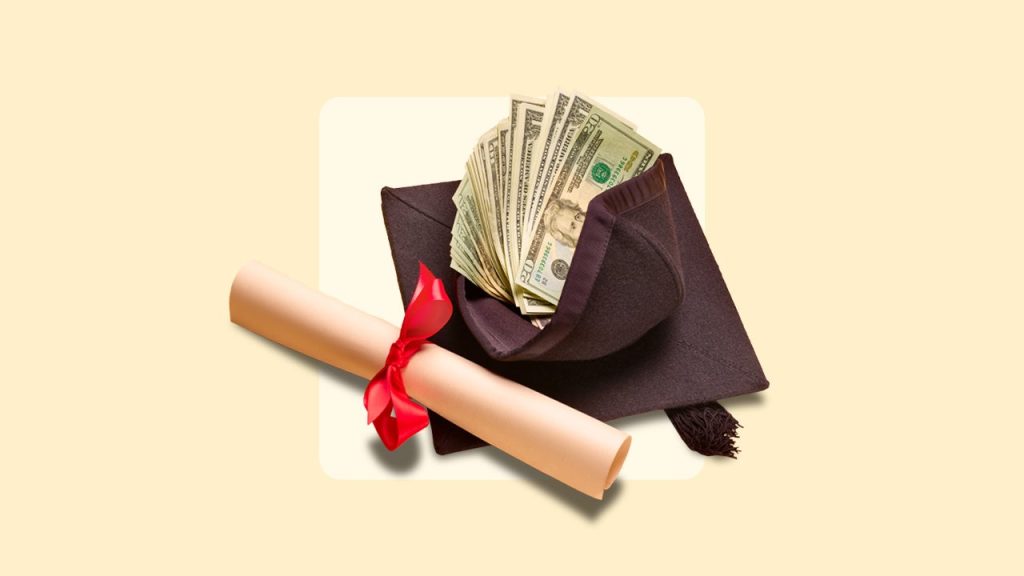Key takeaways
- Earning a graduate degree can lead to higher earnings, but there are costs involved in attending school for a longer time.
- Most student loan repayment plans last from 10 to 25 years — a long time to commit to monthly loan payments.
- Several strategies can help you make lower monthly payments, pay down student debt faster or both.
Although earning a graduate degree can lead to higher wages over the course of a career, attending college for several more years can lead to much higher costs for school. You may have to take out a graduate student loan to pay for it. Depending on the amount you borrow, it could take decades to repay the loan, making it challenging to tackle future financial goals like retirement or buying a home.
Fortunately, there are ways to pay down graduate school loans faster or even get some financial help throughout the process. If you’re wondering how to pay them off faster or at a lower total cost, consider the following tips.
1. Find a different repayment plan
If you take out federal student loans, you’ll automatically be placed on the Standard Repayment Plan, which lasts 10 years, but you aren’t locked into this plan, and you can change it to a lower monthly payment over a longer timeline if you prefer.
Income-driven repayment plans are one option. These plans cap payments at a percentage of your discretionary income, usually 10 to 20 percent, which you’ll pay over 20 to 25 years before your remaining balance is forgiven.
On the upside, these plans can help you make a considerably lower monthly payment depending on your income and family size, but you’ll also be making payments over a few decades. Fluctuations in your income can lead to making larger monthly payments as you progress in your career.
In the news
As of March 26, the U.S. Department of Education has restored access to applications for Income-Based Repayment, Pay As You Earn and Income-Contingent Repayment plans. Applications for the SAVE plan and the retired Revised Pay As You Earn plan remain unavailable, with the Trump administration referring to these plans as “illegal.” According to Acting ED Under Secretary James Bergeron, the reopened applications have been revised to bring them into compliance with an 8th Circuit Court of Appeals injunction issued in February.
2. Make additional monthly payments
Because federal student loans and most private student loans don’t have prepayment penalties, you could also take the opposite approach and choose to repay your loans over a shorter time by making additional payments.
According to higher education consultant Tom O’Hare of Get College Going, adding a small additional monthly payment ($50 or $100) toward the loan balance is a smart way to reduce the repayment term and save money over time.
“The additional payment will shorten the repayment term by months and years and the overall interest paid by the borrower,” he said.
Also make sure to check for potential discounts you can qualify for with your loans, which can lead to additional savings. For example, O’Hare says signing up for automatic payments for your loan may lead to a small interest rate reduction that lasts for the duration of the repayment process.
3. Consider refinancing to a lower interest rate
If you took out your student loans with high interest rates, refinancing your loan to a lower interest rate can help you save money and pay off your loans faster since more of your monthly payment will go toward the principal.
You can refinance both federal and private student loans. Be warned that refinancing your federal student loans with a private lender means you’ll lose access to income-driven repayment plans, loan forgiveness options and an abundance of deferment and forbearance programs.
According to O’Hare, refinancing with a private loan company can be an excellent way for borrowers to reduce their interest rates, adjust their monthly payments and make other changes to their loan obligations. This strategy works best for graduates who have reliable employment and strong incomes, as well as those who are fine losing out on federal student loan benefits.
Shop around
If you do choose to refinance your student loans, it’s important to compare rates from a few lenders before applying. Your finances and credit score for student loans determine what rate you receive, and each lender weighs these factors differently. If you don’t know where to start, you can check out multiple rates from different lenders by filling out a single form on a loan comparison website.
4. Figure out ways to earn more money
For someone with a large graduate loan debt balance, getting a side gig could help knock that debt out faster. Even if you earn an extra $100 every month and put it toward your student loan debt, you’ll eliminate $1,200 per year from your balance and save money on interest by paying the principal of the loan down faster. Side hustles can help you decrease your student loan balance over time.
Financial advisor R.J. Weiss of The Ways to Wealth also cautions against letting additional earnings trick you into upgrading your standard of living.
You want to keep your living expenses low, including your minimum student loan payments, and then use the gap between your income and expenses to make extra payments on your loans.
— R.J. Weiss, Financial Advisor
Weiss also counsels his clients not to upgrade their lifestyle too quickly as their earnings increase, especially if they have student loans. “If you suddenly take on a higher rent, buy a new car or make other big purchases, you’ve created a new spending baseline that’s hard to scale back from,” says Weiss. “It’s tough to go backwards once you’ve gotten used to those upgrades.”
Keep in mind:
Side hustles on top of a regular job can easily result in burnout, so make sure you’re maintaining some work-life balance.
5. Look into employee assistance programs
Some companies offer to help employees with their education expenses as part of their benefits package. This can be in the form of either tuition reimbursement or an allowance to pay off your student loans.
Many companies institute an annual cap of $5,250, since that is the maximum contribution that can be tax-free for the employer and the employee through December 31, 2025, under current law. Additionally, some conditions may be attached, like staying with the company for a specified amount of time and meeting certain performance metrics.
COO Patricia Roberts for Gift of College, a social savings platform and support for people paying down student debt, says employer assistance with student debt is one of the most overlooked ways to tackle graduate-level education. Not only do employers recognize the stress employees experience repaying their student debt but they also realize their workers often need those credentials to qualify for their current roles.
“The cost of losing a valuable employee can be high,” she says. “If student loan debt is weighing you down, it’s worth asking your employer if they’d be willing to help.”
6. Learn how to budget
When it comes to balancing lifestyle expenses with paying down debt, creating a basic budget is a critical part of the process. Student loans take up a relatively fixed spot in your budget, so examine your expenses to see where you can cut back.
Start by writing down your spending and expenses in a notebook or a spreadsheet. You can also use a budgeting app if you don’t feel like crunching the numbers yourself. After seeing it all in one place, it’ll be easier to determine what your discretionary spending should be after accounting for your fixed expenses.
Weiss says that recent college graduates may have an advantage when it comes to budgeting since most are coming out of a period of being extremely frugal. “If they can keep that mindset for just a few more years while prioritizing paying off their student loans in those years, they can put a big dent in their student loans and avoid being weighed down by them for decades,” he says.
50/30/20 rule
You can try implementing the 50/30/20 rule — 50 percent of your take-home pay goes toward needs, such as housing, groceries and utilities; 30 percent goes toward wants, such as hobbies and vacations; and 20 percent goes toward savings, such as an emergency fund and investments.
Bottom line
It’s easy to become overwhelmed by graduate student loans, but plenty of strategies exist to start paying them off. You may even combine a few methods to get the most value from your payments. Before starting your repayment, look at your finances and use student loan calculators to crunch the numbers based on current and future interest rates and repayment terms.
Read the full article here









